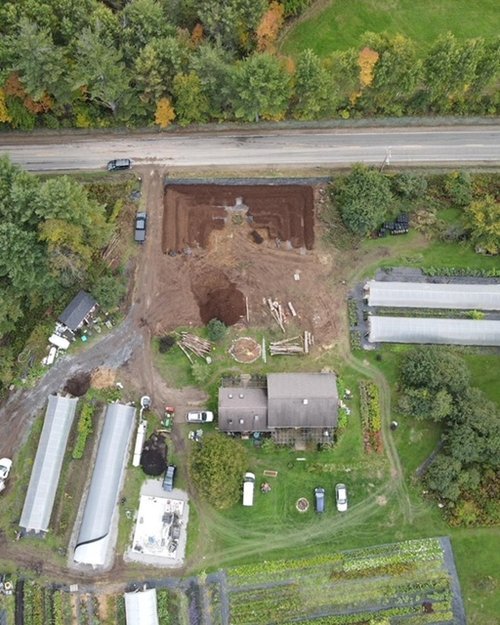hügelkulture gardening
I have long struggled with the perennial beds at the front of our property. They existed in this weird state of experimentation- a 100ft x 100ft mess of weeds and flowering plants…and let’s be honest—more weeds. And none of the experiments seemed to work. I tried mounding up the soil to create better drainage in the soggy clay soil. But then the aisles were narrow, steep-sided and difficult to navigate. We tried growing our plants through landscape fabric to prevent an invasion of weeds, but the plants were then choked by the fabric and difficult to access for fertilizing and dividing. The plants we didn’t grow through fabric were hopelessly suffocated by weeds. So, by the beginning of this season I was kind of at my wits end with it. I knew we needed to do something big and overhaul the space. We needed a fresh start and a better foundation.
Our farm manager suggested that we look into Hügelkukture and that we talk to a local expert. So we consulted Adirondack Farm & Forest about an ambitious plan to make a large network of raised beds. When I asked the firm how they planned to help us irrigate the garden I was surprised by their answer: “you don’t need to.” What?!
That’s right. The composition of the beds themselves retains moisture, “you probably won’t have to water at all,” I was told.
The foundation of Hügelkulture gardening may be best explained by thinking about what happens naturally in the woods when a tree falls to the ground. As it starts to break down it absorbs moisture— like a sponge. Anyone who has been hiking in the woods and stepped on or climbed over a mossy fallen tree trunk knows what I mean. New life starts to grow in that tree as it breaks down. We see moss, saplings, fungi, insects —a whole new ecosystem growing in/on that fallen tree. The phenomenon really made sense to me when I pulled a small log out of our compost area last spring and squeezed its material in my hand. It had the consistency of a kitchen sponge. That’s when I got it.
Our new Hügelkulture beds were made from trenches dug with an excavator— about 2 ft deep and wide by however long the rows are (I designed a concentric pattern of square shapes with intersections and circle-shaped round-abouts to make things nice and complicated). Eeek!
This photo shows the Hugelkulture display garden under construction at our farm, along the road.
Next, tree trunks and branches from a row of pines threatening to fall on our home or greenhouses were cut to length and placed in the bottom of each trench. Carter at Adirondack Farm & Forest assured us that the acidity of the pines would be ok to work with and that he had experience building beds with them before.
Compost from our friends at Blue Line Compost here in the Adirondacks was delivered and added to the trenches before the soil was replaced and mounded over the top. The whole garden was covered with a thick layer of mulch (6-10 inches deep in some places) which was delivered by tractor trailer. We brought in 70 cubic yards and have about a 1/4 of it left to use for mulching other places on the farm. (We always need mulch.) We put landscape fabric in the aisles, only, and mulched over it, too.
The finished beds look like a series of burial mounds. But essentially, they are nicely formed raised beds with a supply of organic material inside of them that will break down and improve our soil structure and feed our plants for many years to come.
We started planting into our beds as soon as they were finished. The perennials and bulbs we dug out before the construction were waiting in crates and buckets in the shade along the edges of our property. If you have existing plants that you’d like to save, consider taking on a project like this in the fall or spring (or winter in mild climates) when the temperatures are cool and your plants are dormant.
We are thrilled with the outcome of this project so far. Seeing how things develop in the spring will be the true test. We are planting thousands of bulbs - tulips, daffodils, fritillaria, allium, muscari, hyacinth - into the beds and trying to plan the garden so that each row is always in bloom during the season. That is a fun puzzle for me, because I generally think of myself as a farmer more than a landscaper. I love the simplicity of the rows in the flower field where we are focused on one crop at a time and empty each space before moving different plants in. This is a different way of thinking. It’s “no-till” to the max. And I’ll be very curious to see/unsurprised if our experience with the Hügelkulture beds totally changes how we approach flower farming all together.
Bella stands over a tulip display we planted along the outside edge of the garden prior to covering last fall.
We’ll let you know how things develop in the spring! In the meantime, please share your questions/thoughts on Hügelkulture gardening in the comments below. We’d love to chat with you.
Best,
Ready to learn more?
We have lots more to share! Learn more about the Pro Platform- where we share weekly behind the scenes video tips about our favorite plants, efficient processes, and must-have tools. Members have access to the full library, plus downloads and templates, our vendor lists, special offers, and a tool gallery.
0 Likes




